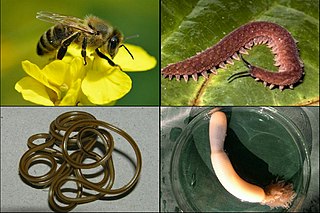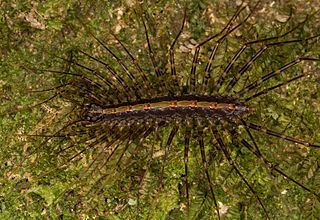
Arachnida is a class of joint-legged arthropods, in the subphylum Chelicerata. Arachnida includes, among others, spiders, scorpions, ticks, mites, pseudoscorpions, harvestmen, camel spiders, whip spiders and vinegaroons.

Ecdysozoa is a group of protostome animals, including Arthropoda, Nematoda, and several smaller phyla. The grouping of these animal phyla into a single clade was first proposed by Eernisse et al. (1992) based on a phylogenetic analysis of 141 morphological characters of ultrastructural and embryological phenotypes. This clade, that is, a group consisting of a common ancestor and all its descendants, was formally named by Aguinaldo et al. in 1997, based mainly on phylogenetic trees constructed using 18S ribosomal RNA genes.

Panarthropoda is a proposed animal clade containing the extant phyla Arthropoda, Tardigrada and Onychophora. Panarthropods also include extinct marine legged worms known as lobopodians ("Lobopodia"), a paraphyletic group where the last common ancestor and basal members (stem-group) of each extant panarthropod phylum are thought to have risen. However the term "Lobopodia" is sometimes expanded to include tardigrades and onychophorans as well.
Niles Eldredge is an American biologist and paleontologist, who, along with Stephen Jay Gould, proposed the theory of punctuated equilibrium in 1972.

Richard Alan Fortey is a British palaeontologist, natural historian, writer and television presenter, who served as president of the Geological Society of London for its bicentennial year of 2007.

Cretoperipatus burmiticus is an extinct species of velvet worm that is known from the Burmese amber in Kachin state of Myanmar, originating from the Cenomanian-Turonian stages of the Late Cretaceous.

Ambulacraria, or Coelomopora, is a clade of invertebrate phyla that includes echinoderms and hemichordates; a member of this group is called an ambulacrarian. Phylogenetic analysis suggests the echinoderms and hemichordates separated around 533 million years ago. The Ambulacraria are part of the deuterostomes, a clade that also includes the many Chordata, and the few extinct species belonging to the Vetulicolia.

The Craterostigmomorpha are the least diverse centipede clade, comprising only two extant species, both in the genus Craterostigmus. Their geographic range is restricted to Tasmania and New Zealand. There is a single ocellus on each side of the head capsule. They have a distinct body plan; their anamorphosis comprises a single stage: in their first moult, they grow from having 12 trunk segments to having 15. Adult centipedes in this order, like those in Scutigeromorpha and Lithobiomorpha, have 15 leg-bearing segments. Their low diversity and intermediate position between the primitive anamorphic centipedes and the derived Epimorpha has led to them being likened to the platypus. They represent the survivors of a once diverse clade. Maternal brooding unites the Craterostigmomorpha with the Epimorpha into the clade Phylactometria which includes Craterostigmomorpha, Scolopendromorpha and Geophilomorpha. This trait is thought to be closely linked with the presence of sternal pores, which secrete sticky or noxious secretions, which mainly serve to repel predators and parasites. The presence of these pores on the Devonian Devonobius which is included in own order Devonobiomorpha permits its inclusion in this clade, allowing its divergence of Lithobiomorpha from Phylactometria to be dated to 375 million years ago.
The Myriochelata or Paradoxopoda, is a proposed grouping of arthropods comprising the Myriapoda and Chelicerata. If this proposition holds true, the Myriochelata are the sister clade to the Pancrustacea, comprising classic crustaceans and hexapods.

Protostomia is the clade of animals once thought to be characterized by the formation of the organism's mouth before its anus during embryonic development. This nature has since been discovered to be extremely variable among Protostomia's members, although the reverse is typically true of its sister clade, Deuterostomia. Well known examples of protostomes are arthropods, molluscs, annelids, flatworms and nematodes. They are also called schizocoelomates since schizocoely typically occurs in them.

Planulozoa is a clade which includes the Placozoa, Cnidaria and the Bilateria. The designation Planulozoa may be considered a synonym to Parahoxozoa. Within Planulozoa, the Placozoa may be a sister of Cnidaria to the exclusion of Bilateria. The clade excludes basal animals such as the Ctenophora, and Porifera (sponges). Although this clade was sometimes used to specify a clade of Cnidaria and Bilateria to the exclusion of Placozoa, this is no longer favoured due to recent data indicating a sister group relationship between Cnidaria and Placozoa.

Mark James Handley is Professor of Networked Systems in the Department of Computer Science of University College London since 2003, where he leads the Networks Research Group.

Peripatidae is a family of velvet worms. The oldest putative representatives of the family herald from Burmese amber dated to the mid-Cretaceous, around 100 million years ago, with representatives from Dominican and Baltic amber attesting to a broader distribution in the Palaeogene / Neogene; molecular variability suggests that the family's crown group may have arisen in the early Mesozoic.
Euan N.K. Clarkson FRSE is a British palaeontologist and writer.

ParaHoxozoa is a clade of animals that consists of Bilateria, Placozoa, and Cnidaria. The relationship of this clade relative to the two other animal lineages Ctenophora and Porifera is debated. Some phylogenomic studies have presented evidence supporting Ctenophora as the sister to Parahoxozoa and Porifera as the sister group to the rest of animals. Some studies have presented evidence supporting Porifera as the sister to Parahoxozoa and Ctenophora as the sister group to the rest of animals.
Gonzalo Giribet is a Spanish-American invertebrate zoologist and Alexander Agassiz Professor of zoology working on systematics and biogeography at the Museum of Comparative Zoology in Harvard University. He is a past president of the International Society for Invertebrate Morphology, of the Willi Hennig Society, and vice-president of the Sociedad Española de Malacología.
Dendrothereua is a genus of house centipedes in the family Scutigeridae. There are at least three described species in Dendrothereua, found in the southern United States and the Neotropics.

Pselliodidae is a family of small centipedes, identical and closely related to house centipedes.
Steven H. D. Haddock is a marine biologist known for his work on bioluminescence of the jellylike animals of the open ocean and the deep sea, and the photoproteins and fluorescent proteins of these animals.

Mosineia is a genus of euthycarcinoid arthropods that lived on tidal flats of Laurentia at what is now central Wisconsin from the Middle Cambrian to the Late Cambrian. It contains a single species, Mosineia macnaughtoni. Associated trace fossil evidence suggests that this genus spent some of its time subaerially, possibly to mate and to feed on the microbial mats that blanketed the beaches. The genus is named after Mosinee---the city in Marathon County, Wisconsin, near which the fossils were found. The collecting site is known as Blackberry Hill, which is a well known Konservat-Lagerstätte that produces abundant exceptionally preserved fossils.













